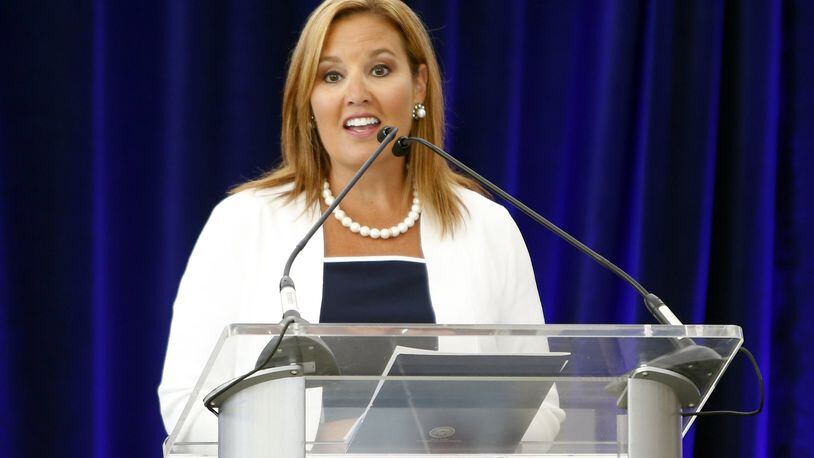In an exclusive interview with the Dayton Daily News, Taylor recounted some of the harrowing moments her family has endured over the past five years, including failed drug rehab programs, two overdoses at home, and urgent calls for ambulances.
Silent killer, no one is off limits. Thanks for telling your story @MaryTaylorOH https://t.co/0KZRjWprnf
— Brady Leonard (@bradyleonard) June 2, 2017
“Until we found the treatment that worked for (our sons,) the voice of worry was very loud and it was very scary. Very scary,” said Taylor, who says both sons are now doing well.
Taylor’s competitors in the 2018 governor’s race extended their thoughts and prayers for her family and all Ohioans who are struggling with addiction. Each one pledged to take comprehensive approaches to fighting the scourge.
“It is everywhere. That’s what I’ve been saying,” said Dayton Mayor Nan Whaley after reading the story.
“I can only imagine what their family has gone through and I hope everything works out for them,” said state Sen. Joe Schiavoni, D-Boardman.
Even in the best families: Two sons of Ohio Lt. Gov Mary Taylor were addicted to opioids. Kudos @lbischoff for this: https://t.co/f1fPsHC1vL
— Walter Shapiro (@MrWalterShapiro) June 2, 2017
But while Taylor’s competitors may sympathize with her family’s personal struggles to deal with addiction, her strategy for dealing with the problem is in stark contrast to some of her competitors in the race for governor, particularly those on the Democratic side.
Taylor, a Republican, opposes the expansion of Medicaid, which was made possible by Obamacare, arguing that it’s not sustainable.
Every Democrat in the race — Whaley, Schiavoni, former U.S. Rep. Betty Sutton, and former state Rep. Connie Pillich — all support Medicaid expansion, and see it as a key to getting people help for their drug addictions.
Medicaid provides health care coverage to an additional 715,000 low-income Ohioans — roughly one-third of them with drug abuse issues, according to Medicaid data.
“The most harmful thing we could do is to end this coverage and end the path to recovery for tens of thousands of Ohioans,” said John Corlett, president of The Center for Community Solutions and a former Ohio Medicaid director.
Opinions about Medicaid expansion from the Republican side are less definitive.
U.S. Rep. Jim Renacci, R-Wadsworth, said in a written statement that the state plays a role in helping people get drug treatment but expanded Medicaid isn’t the mechanism. “With cost estimates ranging from $4 billion to $14 billion over the next eight years, Medicaid expansion is fiscally unsustainable and will siphon resources from other vital programs if not repealed — including drug treatment and prevention programs,” he said. “Ohio should retain more of the tax dollars sent to Washington and total control over Medicaid so my administration can implement a program that meets Ohio’s needs, including dealing with this devastating crisis.”
Secretary of State Jon Husted said in an interview that a national response is needed, including a mechanism for covering effective drug treatment and recovery options.
“Make no mistake. I am for providing treatment for people who are suffering from opioid addiction,” he said. “It is killing people. It is an epidemic.”
He said funding can come through Medicaid, local levies, subsidies for private insurance or other options, but added: “This does not need to be caught up in Obamacare.”
Those who argue for expansion say treatment is expensive and out of reach for many families. The cost of treatment varies based on who is paying the tab — self-pay, Medicaid or private insurance — and what combination of treatment is needed, experts say.
But a full year of methadone maintenance, a drug used to quash opioid cravings, costs $4,700 per patient, according to the National Institute on Drug Abuse. Some medications are considerably more expensive.
Ohio Medicaid covers half of all medication-assisted drug addiction treatment in Ohio.
Going without treatment can be deadly.
Since 2007, 21,000 Ohioans have died of accidental drug overdoses, according to Ohio Department of Health data. Without deployment of naloxone — a drug that reverses the effect of an opioid overdose — the fatalities could be even higher. In 2015, firefighters, paramedics and other first responders administered naloxone 19,782 times in Ohio.
Staff writer Will Garbe contributed to this report.
About the Author
